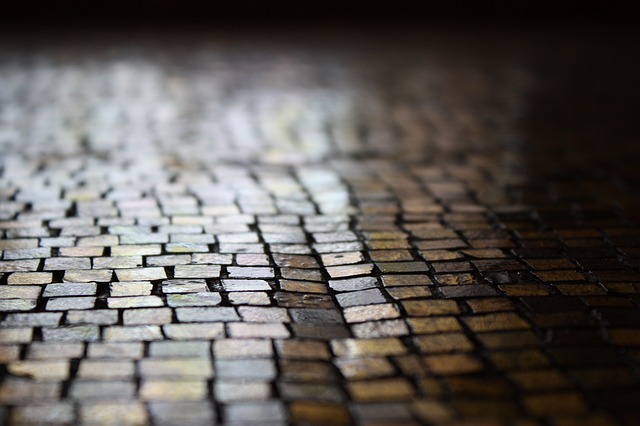Tessera
Tessera, often known by its plural, tesserae, is the term for an individual tile used in decorative mosaics. They are usually cubic and made of stone, glass, ceramic or other hard materials.
By 200 BC, the earliest forms of tesserae, made from marble and limestone, had replaced natural pebbles in the mosaics created by Hellenic builders. Roman mosaics, used to decorate both panels and floors, tended to use stone cut into small cubes and arranged in designs and geometric patterns.
At around the same time, tesserae made of smalto (coloured glass) began to be produced to provide mosaics with colours that could not be found in natural stone. Between the first and third centuries AD, glass tesserae started to be used for wall mosaics as they were not required to be as durable as floors, for which stone still tended to be favoured.
A variation of glass tesserae were made with thin plates of gold or silver sandwiched between two slabs of molten glass and cut into cubes. These were a common feature in Early Christian and Byzantine mosaics.
Ceramic tesserae became common in the Middle Ages, later rivaling glass as a major material in modern mosaics. As well as ceramic, other materials that have been used to form tesserae include shell, painted stone, terracotta, enamel and mother-of-pearl.
[edit] Related articles on Designing Buildings Wiki
Featured articles and news
Latest Build UK Building Safety Regime explainer published
Key elements in one short, now updated document.
UKGBC launch the UK Climate Resilience Roadmap
First guidance of its kind on direct climate impacts for the built environment and how it can adapt.
CLC Health, Safety and Wellbeing Strategy 2025
Launched by the Minister for Industry to look at fatalities on site, improving mental health and other issues.
One of the most impressive Victorian architects. Book review.
Common Assessment Standard now with building safety
New CAS update now includes mandatory building safety questions.
RTPI leader to become new CIOB Chief Executive Officer
Dr Victoria Hills MRTPI, FICE to take over after Caroline Gumble’s departure.
Social and affordable housing, a long term plan for delivery
The “Delivering a Decade of Renewal for Social and Affordable Housing” strategy sets out future path.
A change to adoptive architecture
Effects of global weather warming on architectural detailing, material choice and human interaction.
The proposed publicly owned and backed subsidiary of Homes England, to facilitate new homes.
How big is the problem and what can we do to mitigate the effects?
Overheating guidance and tools for building designers
A number of cool guides to help with the heat.
The UK's Modern Industrial Strategy: A 10 year plan
Previous consultation criticism, current key elements and general support with some persisting reservations.
Building Safety Regulator reforms
New roles, new staff and a new fast track service pave the way for a single construction regulator.
Architectural Technologist CPDs and Communications
CIAT CPD… and how you can do it!
Cooling centres and cool spaces
Managing extreme heat in cities by directing the public to places for heat stress relief and water sources.
Winter gardens: A brief history and warm variations
Extending the season with glass in different forms and terms.
Restoring Great Yarmouth's Winter Gardens
Transforming one of the least sustainable constructions imaginable.























